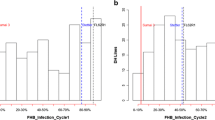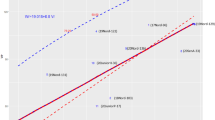Abstract
Fusarium head blight (FHB), caused by Fusarium graminearum Schwabe [telomorph:Gibberella zeae Schw. (Petch)], is an increasingly important disease of wheat (Triticum aestivum L.). Host-plant resistance is considered to be the most economical means of control, but a lack of unique sources of resistance has hindered efforts to breed resistant varieties. The soft red winter wheat, Ernie, has moderately high FHB resistance and is widely used in U.S. breeding programs; however, the genetics of resistance have not been studied. The objectives of this study were to estimate the genetic effects, gene numbers, and heritability for traits related to FHB resistance in Ernie through generation means analyses and variance analyses of 243 F3-derived F8 and F9 recombinant inbred lines (RILs). Replicated experiments were grown in the greenhouse, inoculated with F. graminearum, and evaluated for disease spread and the FHB index (FHBI). The latter was calculated as the percentage of diseased spikelets in inoculated spikes and is often referred to as type-II resistance. Gene action for both disease spread and FHBI was primarily additive with partial dominance for low disease. Broad-sense heritabilities for spread and FHBI were 78.2% and 78.3%, respectively, while the narrow-sense heritabilities were 51.3% and 55.4%, respectively. Line-mean heritabilities from analyses of variance of RILs were 0.70 and 0.87 for spread and FHBI, respectively. A minimum of four genes conditioned both disease spread and FHBI. These results suggest that breeders should be able to enhance FHB resistance by combining the resistance in Ernie with other complementary additive sources of resistance.

Similar content being viewed by others
References
Bai G, Shaner G (1994) Scab of wheat: prospects for control. Plant Dis 78:760–766
Bai G, Shaner G, Ohm H (2000) Inheritance of resistance to Fusarium graminearum in wheat. Theor Appl Genet 100:1–8
Ban T K, Suenaga K (2000) Genetic analysis of resistance to Fusarium head blight caused by Fusarium graminearum in Chinese wheat cultivar Sumai 3 and the Japanese cultivar Saikai 165. Euphytica 113:87–99
Buerstmayr H, Steiner B, Lemmens M, Ruckenbauer P (2000) Resistance to Fusarium head blight in winter wheat: heritability and trait associations. Crop Sci 40:1012–1018
Buerstmayr H, Lemmens M, Hart L, Doldi L, Steiner B, Stierchneider M, Ruckenbauer P (2002) Molecular mapping of QTLs for Fusarium head blight resistance in spring wheat. I. Resistance to fungal spread (type-II resistance). Theor Appl Genet 104:81–91
Chen JL (1989) Research on the inheritance of the resistance to scab in the famous scab resistant cultivar Sumai 3. Shannxi J Agric Sci 2:2–12
Cockerham CC (1983) Covariances of relatives from self-fertilization. Crop Sci 23:1177–1180
Gooding RW, Lafever HN, Campbell KG, Herald LD (1997) Registration of Freedom wheat. Crop Sci 37:1007
Griffey CA, Starling TM, Price AM, Sisson WL, Das MK, Pridgen TH, Vaughn ME, Rohrer WL, Brann DE (2001) Registration of Roane wheat. Crop Sci 41:1359
Hall MD, Van Sanford DA (2003) Diallel analysis of Fusarium head blight resistance in soft red winter wheat. Crop Sci 43:1663–1670
Knapp SJ, Stroup WW, Ross WM (1985) Exact confidence intervals for heritability on a progeny mean basis. Crop Sci 25:192–194
Kolb FL, Bai GH, Muehlbauer GJ, Anderson JA, Smith KP, Fedak G (2001) Host plant resistance genes for Fusarium head blight: mapping and manipulation with molecular markers. Crop Sci 41:611–619
Liao YC, Yu YY (1985) Genetic analysis on scab resistance in local wheat cultivar Wangshuibai. J Huazhong Agric Univ 4:6–14
Liu DJ, Weng YQ, Chen PD, Wang YN (1989) Gene transfer of scab resistance from Roegneria kamoji and Elymus giganteus to common wheat. Jiangsu Agric Sci [Suppl 1]:97–100
Mather K, Jinks JL (1977) Introduction to biometrical genetics. Cornell University Press, Ithaca
McKendry AL, Berg JE, Tague DN, Kephart KD (1995) Registration of ‘Ernie’ wheat. Crop Sci 35:1513
McMullen M P, Schatz B, Stover R, Gregoire T (1997) Studies of fungicide efficacy, application timing, and application technologies to reduce Fusarium head blight and deoxynivalenol. Cereal Res Commun 25:779–783
Mesterházy A (1995) Types and composition of resistance to Fusarium head blight of wheat. Plant Breed 114:377–386
Schroeder HW, Christensen JJ (1963) Factors affecting resistance of wheat to scab caused by Gibberella zeae. Phytopathology 53:831–838
Sheng CS, He JM (1989) Our experience with wheat breeding for scab resistance. Jiangsu Agric Sci [Suppl 1]:58–59
Singh RP, Ma H, Rajaram S (1995) Genetic analysis of resistance to scab in spring wheat cultivar Frontana. Plant Dis 79:238–240
Snijders CHA (1990a). Fusarium head blight and mycotoxin contamination of wheat. Neth J Plant Pathol 96:187–l98
Snijders CHA (1990b) The inheritance of resistance to head blight caused by Fusarium culmorum in winter wheat. Euphytica 50:11–18
Van Ginkel M, Van Der Schaar W, Yang ZP, Rajaram S (1996) Inheritance of resistance to scab in two wheat cultivars from Brazil and China. Plant Dis 80:863–867
Waldron BL, Moreno-Sevilla B, Anderson JA, Stack RW, Frohberg RC (1999) RFLP mapping of QTL for Fusarium head blight resistance in wheat. Crop Sci 39:805–811
Wilcoxson RD, Kommedahl T, Oxmon EA, Windels CE (1988) Occurrence of Fusarium species in scabby wheat from Minnesota and their pathogenicity to wheat. Phytopathology 78:586–589
Windels CE (2000) Economic and social impacts of Fusarium head blight: changing farms and rural communities in the northern great plains. Phytopathology 90:17–21
Windels CE, Kommedahl T (1984) Late season colonization and survival of Fusarium graminearum group II in corn stalks in Minnesota. Plant Dis 68:791–793
Wright S (1968) Evolution and genetics of populations, vol 1. Genetic and biometric foundations. University of Chicago Press, Chicago
Acknowledgements
This research was funded in part by a grant from the U.S. Wheat and Barley Scab Initiative.
Author information
Authors and Affiliations
Corresponding author
Additional information
Communicated by B. Friebe
Rights and permissions
About this article
Cite this article
Liu, S., Abate, Z.A. & McKendry, A.L. Inheritance of Fusarium head blight resistance in the soft red winter wheat Ernie. Theor Appl Genet 110, 454–461 (2005). https://doi.org/10.1007/s00122-004-1852-0
Received:
Accepted:
Published:
Issue Date:
DOI: https://doi.org/10.1007/s00122-004-1852-0




